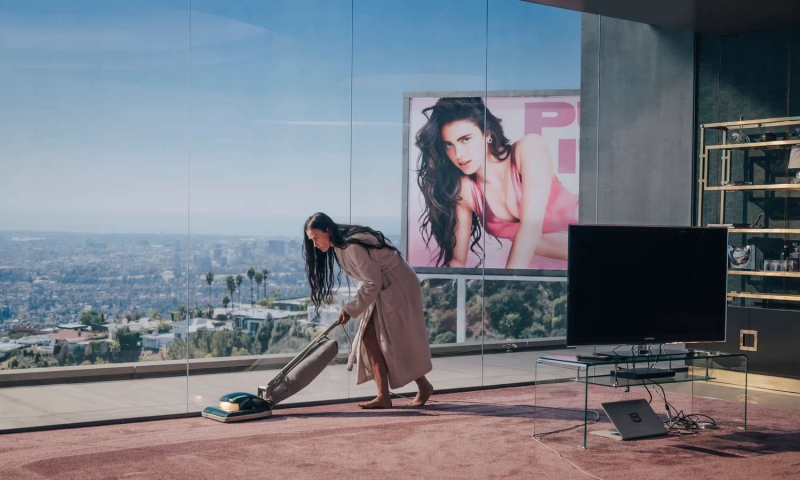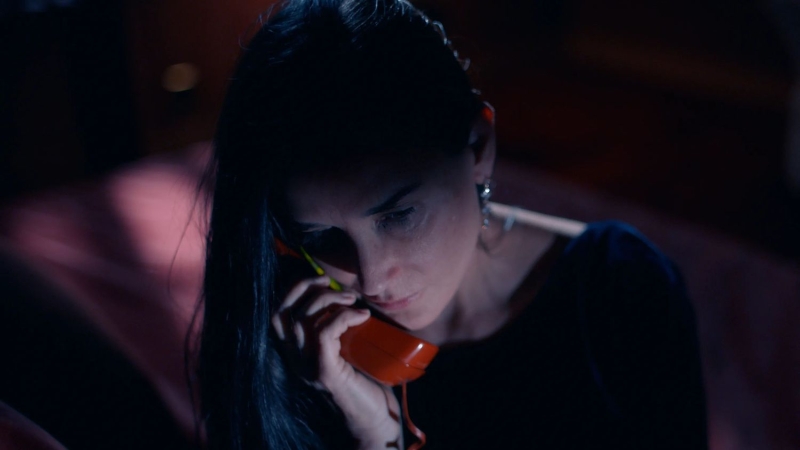Aging may be scary, but not nearly as frightening as the lengths we go to prevent it.
What if a better, more perfect you was just an injection away? Sounds tempting, doesn’t it?
If you’ve ridden the NYC subway recently (or had these targeted ads interrupting your Instagram scroll), you’ve likely seen various billboards pushing drugs that promise to do just that. And as tantalizing as it sounds, you may change your mind after watching director Coralie Fargeat’s The Substance, a new body horror thriller starring Demi Moore and Margaret Qualley (spoilers ahead).
The premise: Moore plays Elisabeth Sparkle, a faded celebrity who hosts a Jazzercise-like TV show and is fired on her 50th birthday in favor of a newer, younger girl. She decides to take this mysterious drug that promises to create a sublime, youthful, beautiful version of herself, which comes in the form of Sue (played by Qualley) splitting open Elisabeth’s spinal column and springing right out of her back, like some twisted origin story of Eve and Eve. Sue’s “birth” is nothing short of cringingly gory, deeply disturbing, and better than Elisabeth could’ve dreamed of. It’s a Faustian bargain for the Ozempic generation. (The fact that the substance in the film is a self-administered treatment was… a choice.)
“Beauty is pain” is one clear motto of the film. However, gore is the narrative mechanism — this isn’t a film for the squeamish. The juxtaposition of Elisabeth’s corporeal carnage with Sue’s triumphant success in resuming Elisabeth’s position as a TV star amplifies how our culture rewards and celebrates young women as it disposes of women who age.
Sue and Elisabeth live at odds with one another in a zero-sum exchange. Sue quickly becomes addicted to how her beauty and youth benefit her career, stealing more time from Elisabeth’s body, which suffers the price of accelerated aging each time Sue delays switching back. Elisabeth is horrified at the toll it takes on her body but can’t give up Sue, who represents everything that makes life worth living. Fargeat literally pits age against beauty until a monstrous finale where neither can survive without the other.
Fargeat literally pits age against beauty until a monstrous finale where neither can survive without the other.
It’s a cinematic parable for the casual violence we enact upon our bodies for beauty. No gore, no gorgeous, as they say (okay, maybe just I say that). The body horror in The Substance is certainly an amplified version of what women are willing to endure in our pursuit of youth and beauty, and it’s no coincidence the film has a woman director and screenwriter at the helm. Our cultural fixation on youthfulness as the defining quality of beauty makes aging so much more daunting by contrast. It’s no wonder we’ve developed a billion-dollar industry to prevent it—one that’s able to innovate in whatever direction our tastes for cosmetic enhancement err. Not long ago, it was overly plump lips and BBLs, and now it’s indetectable tweaks and enhancements.
In many ways, we microdose "the substance" in our everyday lives, but with cheerful proclamations of Botox injections as self-care and filler as empowering. Beauty has always been a conduit to power, especially for women, so this isn’t a moral predicament so much as it is an inventory of the effort women must make to remind everyone of our humanity. (Sue’s reception in the film demonstrates this perfectly.) And since our culture’s dedication to self-capitalization is strong enough to absolve even the most stubborn, age-old stigmas on vanity, empowerment works. But it’s a race against time until we realize that the kind of individual empowerment sought through youthful enhancement also works to enforce the stigmas that make us so fearful of aging to begin with. It’s an investment in our future denigration. Chasing youth will always backfire in a society that reviles and stigmatizes visible signs of aging nearly as much as any evidence of cosmetic intervention to obscure it.

The Substance is well-timed for our current beauty culture that rewards and encourages self-optimization at all costs. It portrays youth almost obscenely with so many slow-motion pans across youthful, perky butts (Qualley’s as well as other disembodied ones) contrasted with shots (soundtracked with classic horror movie orchestral stabs and all) of Moore’s rapidly aging form throughout the film.
At 61, Moore is no candidate for a“before” body-shaming figure; as far as looking good for one’s age (which always seems like a backhanded compliment to me), Moore defies our expected timeline of her age by probably 15-20 years. But it’s a sharp dig at Hollywood’s pattern of disposing of women once they turn a certain age—usually one that suggests they’re no longer fertile. Moore herself has endured those pressures throughout her career. The echo of past tabloid criticism decrying her “botched” cosmetic work resonates in the stakes of Elisabeth’s desire to reclaim her youthful cache. The backlash is something nearly all Hollywood actresses experience if they stay in the industry long enough to succumb to the pressures to remain bankably sexualized and youthful. Qualley, on the other hand, is already the progeny of another of Hollywood’s “aging” actresses, Andie MacDowell (whose embracement of her natural grey hair in her 60s warranted headlines in several mags). That Qualley also springs from Moore in this film — well, the irony is not lost on me.
Ultimately, our culture supports the idea and belief that a better you is an injection away.
Once the film’s very bloody finale happens (I won’t give spoilers, but it’s a campy nod to both Carrie and Frankenstein), I couldn’t help but notice that Elisabeth did not have one single friend in the film. Instead of helping and supporting one another (as the substance is originally purported to do), Sue and Elisabeth compete for control of their life. It’s a lonely idea that not even your clone wants to be your friend.
Beauty culture’s most toxic messaging will always find you in moments of isolation. Sorority and community are how we can engage in beauty in nurturing ways. Perhaps if Elisabeth had even one friend (it’s a horror movie—pointing out obvious implausibilities is par for the course) who she could talk to about her insecurities, maybe they could reassure her that she’s had a great career, secured an incredible apartment, and has a life that's hers to do whatever the hell she wants with—beyond chasing the same gig working for the same asshole (portrayed cartoonishly villainously by Dennis Quaid).

Ultimately, our culture supports the idea and belief that a better you is an injection away. This method of external self-improvement has replaced the type of internal self-actualization that would better inure us against the cruel dismissal of ageism.
Portraying the younger self as a prideful antagonist hits especially close to home. Sue’s irresponsible behavior, which ultimately sabotages them both, makes total sense to me. When I was in my alleged “prime” in my early 20s, there was little I wouldn’t do or disregard for the glory of the present. Youth really knows how to enjoy the moment; it’s the joy and the blind spot of its nature. Ageism is not unlike our economy of planned obsolescence. We value novelty over longevity. It’s our defining existential dilemma.
Aging may be scary, but not nearly as frightening as the lengths we go to prevent it.
The Substance is a reflection of the pain we internalize at the behest of a youth and beauty-addicted society—and the danger of that pain festering into self-hatred. It makes a ghoul of aging as it dangles the indulgent ecstasy of youth in its most erotic peak over the audience. And I’d be remiss if I didn’t mention how The Substance shares its harrowing prophecy of beauty’s future with Ling Ling Huang’s novel Natural Beauty and even the 1992 film Death Becomes Her.
The dark side of beauty is often a seed planted within us when we are young, taking root in our identities the more it’s conflated with one’s self-worth. The fact that, if we're lucky, we will all grow old someday is worth reckoning with as early as possible. When beauty is valued only by such ephemeral measures, we’re doomed to become crisis managers by the time we are old enough to enjoy the wisdom we’ve collected from our experiences. The film poses the unfair question of how much beauty is worth living for versus how much is it worth dying for. But is the kind of beauty that breeds self-hatred and resentment worth preserving? Aging may be scary, but not nearly as frightening as the lengths we go to prevent it.
